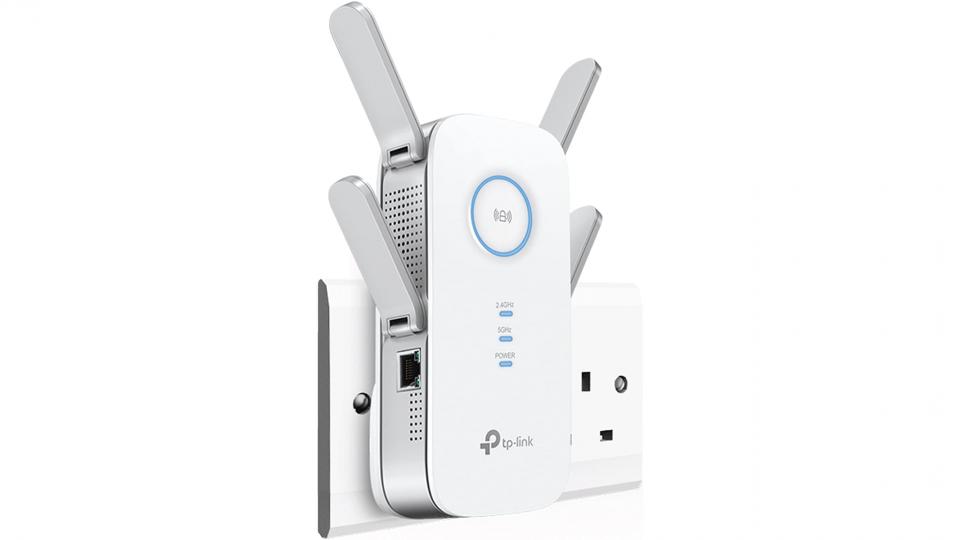
Looking to improve your Wi-Fi? This is our guide to the best wireless extenders for improving speed and coverage throughout your home
No matter how fast your broadband connection, if your Wi-Fi isn’t up to scratch then you’ll be missing out. But you don’t need to buy a new router to give your wireless performance a boost. Choose from our list of the best Wi-Fi extenders below and you’ll be able to strengthen the signal to all areas of your home, as well as potentially benefiting from a much faster connection.
Here’s everything you need to know about these handy devices, along with our selection of the best Wi-Fi extenders on the market.
How to choose the best Wi-Fi extender for you
Is a Wi-Fi extender definitely the answer?
Before you buy an extender, check that it really is the performance of your wireless network that’s slowing you down and not just a slow internet connection. You can use a broadband speed checker to measure download speeds at different distances from your router, and see how the speed drops off as you move around your home.
It’s also worth trying out a few different wireless settings, such as switching radio bands, before you splash out on a new bit of kit. You might find that this gets you a better signal from your existing equipment and that there’s no need to buy an extender at all.
What speeds can I expect?
Some extenders promise data rates as high as 1,733Mbits/sec, which is equivalent to around 216MB/sec and far faster than most broadband connections. In reality, for all sorts of technical and practical reasons, the speeds you see in your own home will be far, far lower.
As a rule, we’re happy with anything over 120Mbits/sec (15MB/sec). To put that into context, Netflix recommends a connection speed of at least 5Mbits/sec for HD streaming and 25Mbits/sec for 4K video. So a good, solid Wi-Fi network should easily be fast enough to cope with multiple simultaneous high-resolution video streams.
What’s the difference between a repeater and a powerline extender?
These are the two main types of extender and they do the same basic job. However, they work in different ways. A Wi-Fi repeater is a single box that relays data back and forth between your router and your wireless devices using Wi-Fi signals alone. If – for example – your router is located at the front of the house, and your home office is at the rear, you can install a repeater at the midway point to boost the signal in the office.
A powerline networking kit consists of two little boxes (sometimes more) that plug into mains sockets around your home. Box number one connects to your router via an Ethernet cable, while box number two broadcasts a wireless signal from wherever it happens to be situated and relays the data back to the first box over your mains electrical wiring.
Powerline systems are often more expensive than repeaters but they’re a fuss-free way to extend a network connection into places that are otherwise hard to reach and can be simpler to set up.
Might I be better off with a mesh Wi-Fi system?
Mesh networking systems work in a similar way to Wi-Fi repeaters but they give you the option of placing multiple nodes all over your home to cover a larger area than a single extender could manage. You can learn more, and explore our recommended models, in our guide to the best mesh Wi-Fi routers.
If you don’t have a huge house, however, a mesh system may be overkill. A regular extender is a lot cheaper and a lot easier to install. Configuring a mesh system normally involves setting up a whole new router, whereas with most repeaters you can simply plug it in, press a button and that’s it.
Does my extender need Ethernet sockets?
In this wireless age, Ethernet sockets might seem a bit outdated. But some devices, such as printers and set-top TV boxes, only support wired connections, and connecting these or a PC to your extender via Ethernet will give you a more reliable and often faster connection than wireless.
Naturally, however, connecting devices to an extender via Ethernet won’t be as fast as a direct wired connection to the router because the signal still needs to travel from your router to the extender over the airwaves first.
What other features should I look for?
Most Wi-Fi extenders have what’s called a “web portal”, which offers a selection of advanced features (some offer a mobile app as well). This is accessed via a web browser, either on your phone or your laptop. Simply type in the address provided by the manufacturer – which is often printed on the extender itself or, failing that, it’ll be in the manual somewhere.
Some of these web portals will let you operate a guest network, with its own name and security settings, so visitors can connect to the internet without having access to your local devices. You might also get access controls, which let you decide exactly who can connect, while scheduling lets you shut off the connection at certain times – useful, perhaps, if you don’t want kids going online in the middle of the night.
Think about physical features when choosing your extender. Most units plug directly into a mains socket, and some models are so big that they block neighbouring outlets from use. A mains passthrough socket on the front can also be very useful if you’re running low on mains sockets and this certainly isn’t something you can take for granted.
READ NEXT: Our pick of the best broadband providers this year
The best Wi-Fi extenders to buy
1. TP-Link RE300: The best budget extender
Price: £35 | Buy now from Very

TP-Link’s RE300 is basic, but it’s incredibly easy to set up via the TP-Link Tether app and it comes with a couple of extra modes to help you make the most of your current wireless network. We found it worked best in default mode, where speeds averaged 11.3MB/sec in testing. If you’re a tinkerer, however, you can also set it up so it uses the faster 5GHz band as a dedicated link to your existing network and the 2.4GHz band for your devices.
Either way, the RE300 works really well. Speeds were quick and connectivity reliable, plus it doesn’t take up too much space in your plug sockets, leaving plenty of room for other devices to use the sockets next to it. The only thing it lacks is an Ethernet port, but this compact unit offers solid performance for not a lot of money.
Key specs – Radio bands (maximum speed): 2.4GHz (300Mbits/sec), 2 x 5GHz (866Mbits/sec); Ethernet ports: None; WPS button: Yes
2. Devolo Magic 1 WiFi: The best powerline extender kit
Price: £130 | Buy now from Amazon

Devolo’s Magic WiFi kit uses powerline networking, so it’s ideal for extending your wireless network into places where your existing router can’t penetrate.
It’s also incredibly easy to set up: connect the base station to your router using the supplied Ethernet cable, plug the wireless access point into a socket somewhere else in your home and it’ll start broadcasting a Wi-Fi signal. There’s a handy pair of Gigabit Ethernet ports at the bottom of the access point, and both units also have convenient mains passthrough sockets on the front. Just note that their chunky design means you might have difficulty situating them alongside anything larger than a regular plug.
The Magic kit gave us strong download rates all around the house, equivalent to around 100Mbits/sec – and advanced users will appreciate the companion app that shows connection diagnostics, so you can work out where to locate the plugs for the best performance. The web portal, meanwhile, lets you manage your wireless configuration, set up a guest network and apply an operating schedule so that (for example) the extended network is only available during office hours.
If your home isn’t Wi-Fi-friendly, this speedy powerline extender is the perfect solution.
Key specs – Radio bands (maximum speed): 2.4GHz (300Mbits/sec), 5GHz (867Mbits/sec); Ethernet ports: 2 x Gigabit; WPS button: Yes
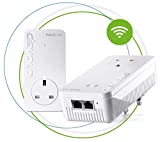
Devolo Magic 1-1200 Wi-Fi Ac Starter Kit: Stable home working, High Performance Powerline Kit, Mesh Wi-Fi, Up to 1200 Mbps Via Powerline, Wi-Fi Ac, Wi-Fi Anywhere, Access Point, 2x Fast Ethernet Ports
£118.00 Buy now 

3. TP-Link RE-650: Faster speeds for multiple devices
Price: £75 | Buy now from Amazon

TP-Link’s extenders are a doddle to set up and install in your home network and do a solid job of extending Wi-Fi connectivity into parts that previously might have been missing out. The RE-650 is the most powerful of the extenders TP-Link offers, and comes with dual-band wireless and a connection speed rated at 2,600Mbits/sec – that’s 800Mbits/sec over 2.4GHz and 1,733Mbits/sec over 5GHz.
Despite these impressive numbers, transfer rates aren’t all that much faster than the cheaper devices. The fastest downloads we saw were 16.8MB/sec in the same room, falling to 9.7MB/sec in a room one wall and one floor away. Still, with 4×4 MU-MIMO technology onboard, it’s better able to serve up that bandwidth to multiple devices than most in this list, so if yours is a busy household it’s worth stumping up the extra for.
Our only gripe is that it’s pretty bulky and, in a typical British double wall socket with central switches, it gets in the way of accessing the socket’s on/off switch.
Key specs – Radio bands (maximum speed): 2.4GHz (800Mbits/sec), 5GHz (1,733Mbits/sec); Ethernet ports: 1 x Gigabit; WPS button: Yes
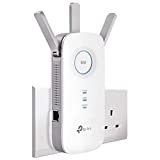
TP-Link AC1750 Universal Dual Band Range Extender, Broadband/Wi-Fi Extender, Wi-Fi Booster/Hotspot with 1 Gigabit Port and 3 External Antennas, Built-in Access Point Mode, UK Plug (RE450), White
£52.03 Buy now 

4. TP-Link RE-450: A great all-rounder at a very affordable price
Price: £75 | Buy now from Amazon

TP-Link’s chunky RE450 extender has been on our recommended list for several years because it does everything you could ask of a Wi-Fi extender at a very fair price.
Its three sticky-out aerials did a solid job of relaying the wireless signal around our home – we measured download speeds of 16MB/sec at close range, and even at the far end of the house the RE450 kept up a very satisfactory 9MB/sec.
While the design looks rather plasticky, it’s pleasingly slim, sticking out just 37mm from the wall, so you shouldn’t trip over it as you walk past. The wide casing means you probably won’t be able to plug anything into the adjacent power socket, but the softly glowing blue ring that encircles the WPS button is quite attractive, and it helpfully turns red to let you know if there’s a problem with the connection. There’s a Gigabit Ethernet socket tucked away at the left-hand side too.
The RE450 isn’t as cheap as the Tenda A15, but it’s a faster and more stylish extender. Don’t be put off by its age: it still deserves its place on anyone’s shortlist.
Key specs – Radio bands (maximum speed): 2.4GHz (450Mbits/sec), 5GHz (1,300Mbits/sec); Ethernet ports: 1 x Gigabit; WPS button: Yes

TP-Link AC1750 Universal Dual Band Range Extender, Broadband/Wi-Fi Extender, Wi-Fi Booster/Hotspot with 1 Gigabit Port and 3 External Antennas, Built-in Access Point Mode, UK Plug (RE450), White
£52.03 Buy now 

5. Netgear Nighthawk X6S EX8000: The fastest, smartest Wi-Fi extender money can buy
Price: £156 | Buy now from Amazon
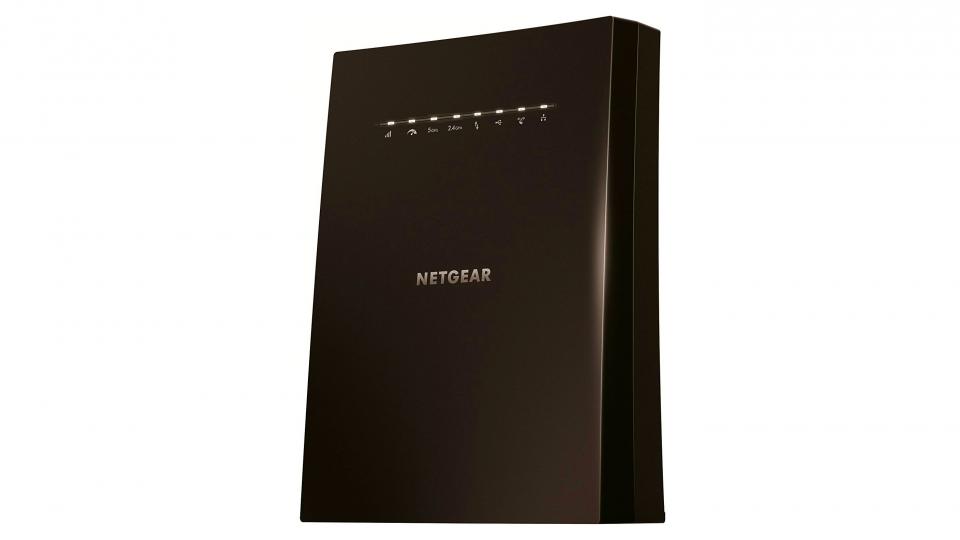
Standing nearly 23cm tall, the Nighthawk X6S is the size of a full-blown router – but that’s justified by what’s inside. While most Wi-Fi extenders use a single 5GHz radio to talk to both your router and connected devices, the X6S boasts a tri-band design, which means backhaul communications don’t have to share bandwidth with client traffic.
This has a huge impact on speed. The X6S is easily the fastest extender we’ve ever tested, managing to project the full bandwidth of a 100Mbits/sec fibre broadband connection to the furthest outposts of our home. That’s the sort of performance we’ve previously only seen from high-end mesh Wi-Fi setups.
The X6S scores highly for features, too. At the rear, there are four Gigabit Ethernet ports, plus a USB port, which you can use to share files and folders over your home network. From the slick web interface you can also audit and block connected clients, set up an access schedule, customise IP address settings and more.
The only catch is the price: the Nighthawk X6S isn’t just the fastest extender we’ve seen – it’s also the most expensive. But if you’re looking for fast file transfers and lots of features, it’s a no-brainer.
Key specs – Radio bands (maximum speed): 2.4GHz (400Mbits/sec), 2 x 5GHz (1,733Mbits/sec); Ethernet ports: 4 x Gigabit; WPS button: Yes
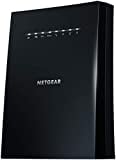
NETGEAR Tri-band Wireless Mesh WiFi Internet Booster Range Extender | Covers up to 2500 sq ft and 50 Devices with AC3000 | Up to 3 Gbps (EX8000)
£124.99 Buy now 

6. Netgear Nighthawk X4S: The best compact tri-band extender
Price: £120 | Buy now from Amazon
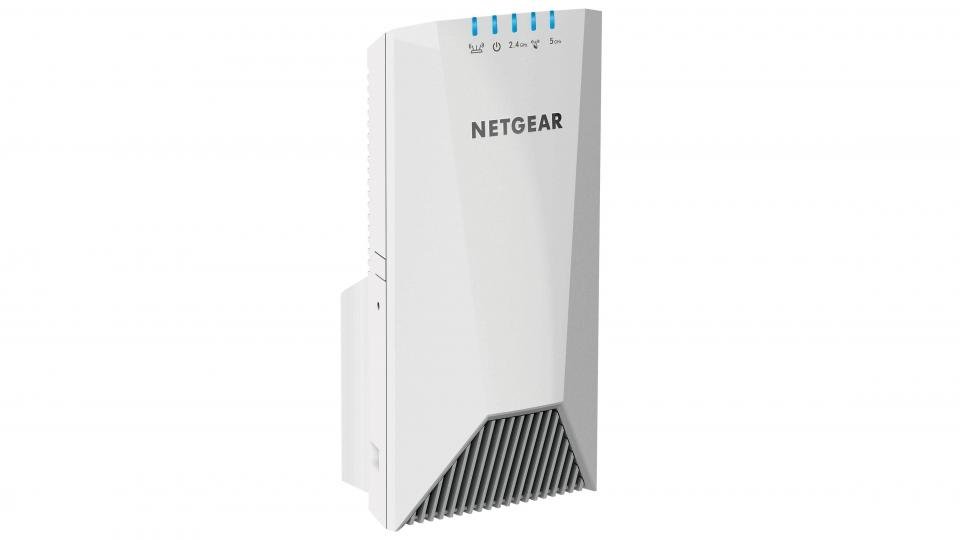
The Netgear Nighthawk X4S uses the same tri-band system as the barnstorming X6S, but it comes in a more compact, wall-mounted form. It’s not quite as powerful – on average we found it delivered around two thirds of the bandwidth of its bigger brother – but it’s still fast enough for more or less anything you might want to do. Even out on the rear terrace behind our home, it kept up a download speed of 5.6MB/sec, which is fast enough to smoothly stream 4K video
You also get that rich management interface, from which you can set up your Wi-Fi just how you like it, configure an access schedule and block individual clients. However, the X4S doesn’t have a USB port, so there are no sharing and streaming options – and there are no Ethernet ports, which is a bit of a shame.
Still, the Netgear Nighthawk X4S is one of the fastest extenders out there, and it’s cheaper and less intrusive than the X6S. Just be warned that, even though the all-in-one design is handy, it’s still big enough to cause potential problems with neighbouring plugs – and there’s no passthrough mains socket.
Key specs – Radio bands (maximum speed): 2.4GHz (400Mbits/sec), 2 x 5GHz (867Mbits/sec); Ethernet ports: None; WPS button: Yes
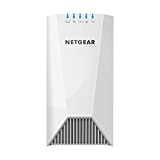
NETGEAR Wifi Mesh Range Extender EX7500 – Coverage up to 2000 sq.ft. and 40 devices with AC2200 Tri-Band Wireless Signal Booster/Repeater (up to 2200Mbps), plus Mesh Smart Roaming with UK Plug
£110.00 Buy now 

7. Devolo Magic 2 WiFi Next: The most reliable extender money can buy
Price: £170 (single extender), £270 (dual extender), £110 (add-on unit) | Buy now from Amazon

Devolo’s Magic 2 Wi-Fi Next straddles the world of wireless extenders, powerline and mesh Wi-Fi and offers a remarkably effective alternative to traditional wireless network hardware. By combining fast 2,400Mbits/sec G.Hn powerline with dual-band 802.1ac Wi-Fi, it delivers the best of all worlds: solid connectivity, even to quite remote locations, and very impressive top speeds as well.
It’s the fastest powerline system we’ve tested and among the best wireless extenders too. We were staggered to find download speeds in our garden office test location were nearly as fast as in the house. Plus, improvements to Wi-Fi in this new “Next” version – including access point steering and 2×2 MU-MIMO – mean it’s now capable of beating many mesh Wi-Fi systems as well.
For homes with out-of-reach places, nothing beats the Devolo Magic 2 WiFi Next at eliminating Wi-Fi notspots. It’s quite pricey but well worth the investment.
Key specs – Radio bands (maximum speeds): 2.4GHz (300Mbits/sec), 5GHz (866Mbits/sec); Powerline speed: 2,400Mbits/sec; Ethernet ports: 2 x Gigabit; WPS button: Yes
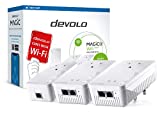
Devolo Magic 2–2400 WiFi Next: Ultimate Whole Home Mesh WiFi Kit Over Powerline, 4k/ 8k UHD Streaming And Stable Home Working (2400 Mbps, 5x Gb LAN ports, G.hn), White
£244.72 Buy now 

